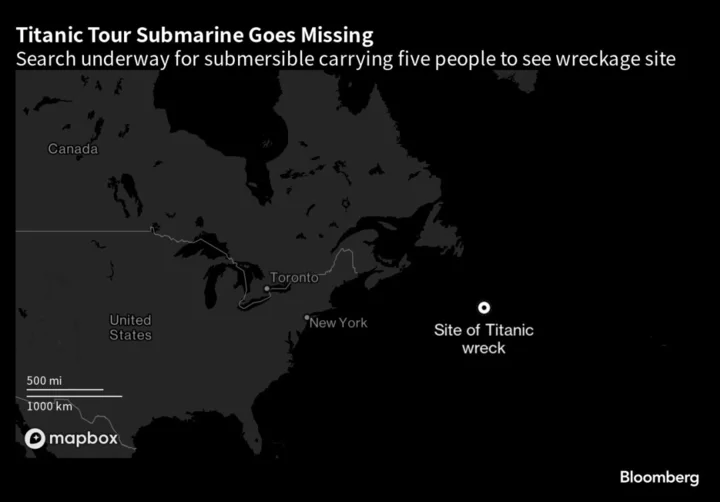A search vessel reached the sea floor near the wreck of the Titanic and began looking for a missing submersible in an increasingly desperate effort to rescue the five-man crew before their dwindling air supply runs out.
The Canadian ship Horizon Atlantic deployed the remotely operated vessel, the US Coast Guard said Thursday in a tweet. French vessel L’Atalante reached the search area and launched its own so-called ROV, the Coast Guard also said.
A fleet of search ships have amassed in the North Atlantic about 900 miles (1,450 kilometers) east of Cape Cod, Massachusetts, since the vessel went missing Sunday on a dive to survey the Titanic. The Coast Guard said Wednesday the Navy was sending a lifting system to the area that can recover large and heavy sunken objects such as aircraft or small boats from deep water.
Time is crucial for the missing crew, if they are still alive and their vessel remains intact. The Titan, which started with about 96 hours of air in case of an emergency, is theoretically down to its final reserves. The crew is also believed to have limited food and water.
“We have to remain optimistic and hopeful,” Coast Guard Captain Jamie Frederick said at a briefing in Boston on Wednesday.
Still, prospects for locating the missing vessel quickly remain dim, said Rob Larter, a marine geophysicist for the British Antarctic Survey, at a Science Media Centre briefing Thursday.
“It’s a needle in a haystack unless you’ve got a precise location,” he said. “It potentially could take weeks of intense survey.”
It’s not clear whether there’s enough time to retrieve the submersible — even if it was found immediately — before its air supplies deplete entirely. On Wednesday, the Coast Guard’s Frederick reiterated that the aim of the taskforce was still to safely rescue Titan’s crew — and the search would carry on for the time being.
With that goal in mind, the Navy’s Flyaway Deep Ocean Salvage System — known as Fadoss — might be able to haul up Titan from the surface. It’s equipped with a motion compensator to offset the heaving movements of the ship during any winching operation.
“Sometimes we don’t find what we’re looking for,” Frederick said. “Sometimes you’re in a position where you have to make a tough decision.”
As equipment and more vessels raced to the search area, the hunt for Titan on Wednesday zeroed in on unidentified noises that have been detected underwater. Remotely operated vehicles were moved to where the sounds were heard and more search equipment will be deployed as it arrives, according to Frederick. The noises were picked up in the past two days by a Canadian aircraft equipped with sonar devices.
“We’re searching where the noises are and that’s all we can do,” Frederick said. “We don’t know what they are, to be frank.”
With few other clues, the unknown sounds have become the focus of the race to find the crew. An armada of vessels from across the world, advised by submarine and ocean experts, are also scouring a vast search area of open water that’s already about twice the size of Connecticut and 2.5 miles deep.
The task of locating and identifying the sounds has been complicated by the clutter of noise from the growing number of boats on the surface. So far, searches by ROVs have come up bare. At the same time, the constantly changing weather, ocean currents and sea conditions mean the search zone is growing by the hour.
“The fact the search area is so large means nobody has been able to confidently locate where those sounds have come from,” Larter said.
A mothership on the surface lost all communications with the Titan on Sunday, about 1 hour and 45 minutes after it began diving toward the Titanic, which sank in 1912 on its first trans-Atlantic voyage. The Titan, a 6.7-meter-long craft made of carbon fiber and titanium, is designed to operate at a maximum depth of 4,000 meters.
The underwater robot deployed by the French, meanwhile, can go as deep as the Titanic site, about 4,000 meters below the surface. Underwater exploration company Magellan will also provide one of their ROVs “in the near future,” the US Coast Guard said Wednesday. Magellan’s equipment can reach depths of up to 6,000 meters and has descended to the Titanic wreck several times.
Several privately owned vessels, one with a decompression chamber and some with underwater search devices, are also preparing to join the search. OceanGate Expeditions, operator of Titan and the Titanic survey trip, is leading the underwater search effort.
The crew onboard the Titan include Hamish Harding, who’s the founder of investment firm Action Group and an avid adventurer, and French maritime expert Paul Henry Nargeolet. The other three are OceanGate founder Stockton Rush, and Shahzada and Suleman Dawood, a father and son in one of Pakistan’s most prominent families.
(Retops with news of ROV reaching the sea floor)
Author: Angus Whitley, Guillermo Molero and Kate Duffy









